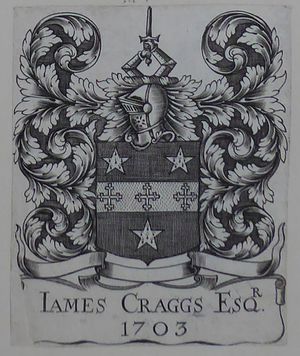Difference between revisions of "James Craggs 1657-1721"
(Created page with "__NOTITLE__ ===name::James name::CRAGGS date of birth::1657-date of death::1721=== file:P1120467(3).JPG|thumb|Craggs's bookplate (British Museum Franks Colle...") |
|||
| (2 intermediate revisions by the same user not shown) | |||
| Line 3: | Line 3: | ||
[[file:P1120467(3).JPG|thumb|Craggs's bookplate (British Museum Franks Collection *425)]] | [[file:P1120467(3).JPG|thumb|Craggs's bookplate (British Museum Franks Collection *425)]] | ||
====Biographical Note==== | ====Biographical Note==== | ||
| − | Son of [[family::Anthony Craggs]] of [[location::Holbeck, County Durham]] and [[family::Anne Morecroft]]. He moved to [[location::London]] | + | Son of [[family::Anthony Craggs]] of [[location::Holbeck, County Durham]] and [[family::Anne Morecroft]]. He moved to [[location::London]] in 1680 and became [[occupation::steward]] to the Duke of Norfolk. He subsequently moved into the employ of the [[associates::John Churchill]], Earl (and later Duke) of Marlborough, through whom his career prospered; he became closely involved with the [[organisations::East India Company]], and wealthy. He was [[occupation::MP]] for [[location::Grampound]] 1702-13 and in 1702 was appointed [[occupation::master general of the ordnance]]. He was much engaged in government affairs during the first two decades of the 18th century, working for [[crossreference::Charles Spencer 1675-1722|Charles Spencer]], Earl of Sunderland, after Marlborough's dismissal. He was heavily involved in the South Sea Bubble in 1720-21, and his estate was forced to pay some compensation to shareholders after his death. |
====Books==== | ====Books==== | ||
| Line 11: | Line 11: | ||
<div id="sourcelist"> | <div id="sourcelist"> | ||
*Gambier Howe, E. R. J. ''Franks bequest: catalogue of British and American book plates bequeathed to the ... British Museum''. London, 1903-4. | *Gambier Howe, E. R. J. ''Franks bequest: catalogue of British and American book plates bequeathed to the ... British Museum''. London, 1903-4. | ||
| − | * | + | *Handley, Stuart. [https://doi.org/10.1093/ref:odnb/6567 "Craggs, James, the elder (bap. 1657, d. 1721), politician and government official."] Oxford Dictionary of National Biography. |
</div> | </div> | ||
Latest revision as of 22:42, 1 May 2021
James CRAGGS 1657-1721
Biographical Note
Son of Anthony Craggs of Holbeck, County Durham and Anne Morecroft. He moved to London in 1680 and became steward to the Duke of Norfolk. He subsequently moved into the employ of the John Churchill, Earl (and later Duke) of Marlborough, through whom his career prospered; he became closely involved with the East India Company, and wealthy. He was MP for Grampound 1702-13 and in 1702 was appointed master general of the ordnance. He was much engaged in government affairs during the first two decades of the 18th century, working for Charles Spencer, Earl of Sunderland, after Marlborough's dismissal. He was heavily involved in the South Sea Bubble in 1720-21, and his estate was forced to pay some compensation to shareholders after his death.
Books
Craggs used an engraved armorial bookplate dated 1703 (Franks *425). The extent of his library is not known; his estate was largely divided between his three daughters after his death (his only son, also James, predeceased him by a few months).
Sources
- Gambier Howe, E. R. J. Franks bequest: catalogue of British and American book plates bequeathed to the ... British Museum. London, 1903-4.
- Handley, Stuart. "Craggs, James, the elder (bap. 1657, d. 1721), politician and government official." Oxford Dictionary of National Biography.
